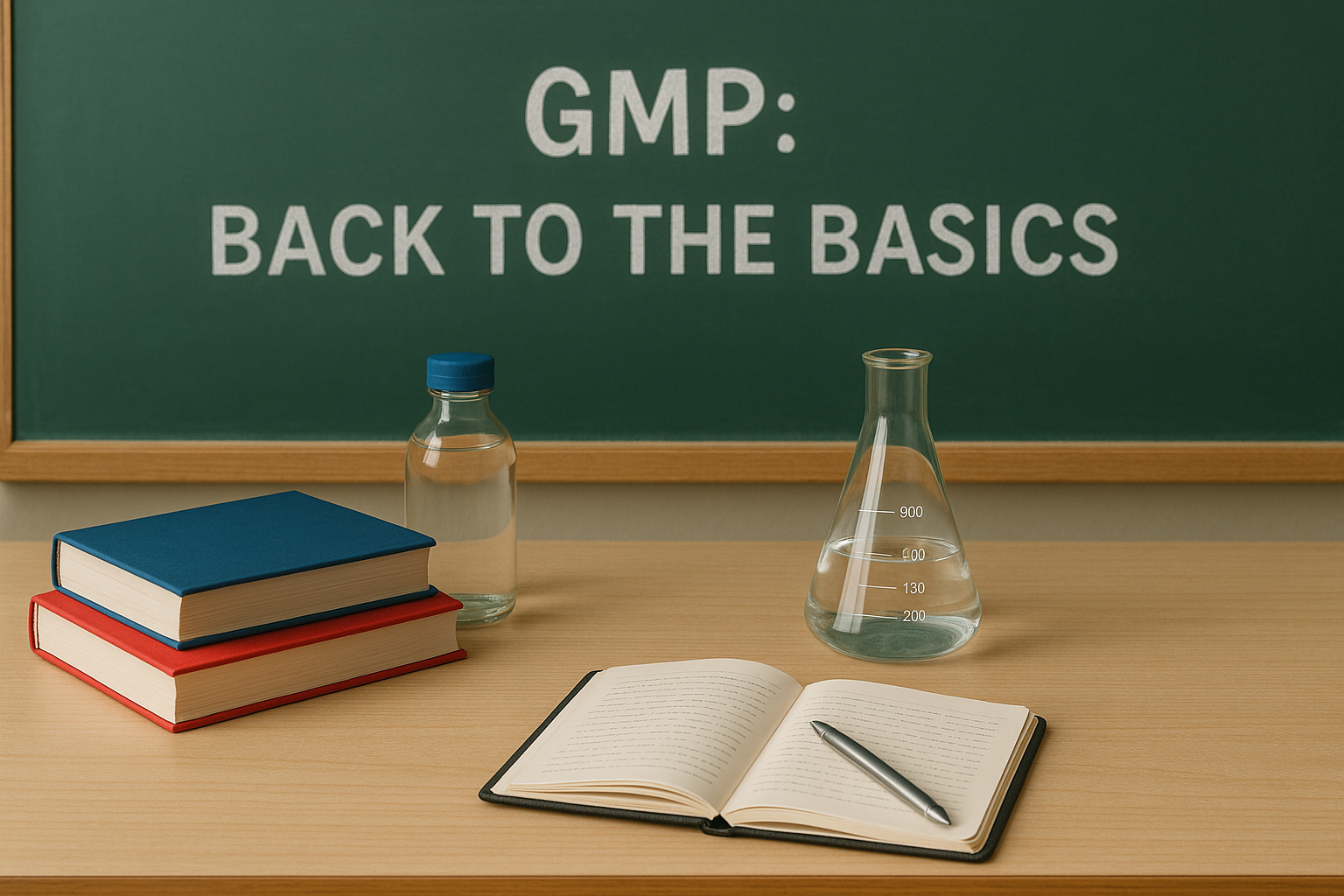
Fractional Leadership in Pharma Quality: When and Why it Works
Fractional leadership is reshaping pharmaceutical quality by delivering seasoned executive expertise exactly when it’s needed most. In today’s landscape of rising regulatory expectations, talent shortages, and cost pressures, fractional leaders bridge critical gaps—preparing firms for inspections, driving remediation, and mentoring teams—without the overhead of permanent hires. This blog explores when the model works best, pitfalls to avoid, and real-world case studies showing how agile, part-time quality leadership can become a lasting strategic advantage.

Back to School, Back to Basics: 10 Habits That Strengthen GMP Compliance
Back-to-school season is the perfect moment to refocus on GMP fundamentals. This blog highlights ten practical habits that strengthen compliance culture, from documenting in real time and following SOPs, to asking questions, keeping organized, and always thinking of the patient first. Compliance isn’t about one-time training—it’s about daily behaviors, reinforced by visible leadership, that protect data integrity, ensure quality, and build trust. Small, consistent habits ultimately safeguard patients and drive sustainable success in regulated manufacturing.

Calculating the True Cost of Quality: A GMP Perspective for Manufacturing Professionals
This blog explores the true Cost of Quality (CoQ) in pharmaceutical GMP manufacturing, emphasizing both visible compliance costs and hidden costs of failures such as recalls, deviations, and regulatory actions. It outlines the four categories of quality costs—prevention, appraisal, internal failure, and external failure—while highlighting their impact on profitability, compliance, and patient safety. By investing in prevention, robust QMS, and workforce training, manufacturers can transform quality from a cost center into a driver of competitive advantage and sustainable growth.

Top 10 Applications ofAI for Improved GMP Quality Systems
Artificial intelligence is reshaping pharmaceutical quality management, offering solutions where traditional GMP systems fall short. This blog explores the top 10 AI applications—from predictive monitoring and NLP-driven document control to AI-enabled CAPA management and supplier oversight—that strengthen compliance, reduce deviations, and enhance product quality. With regulatory expectations evolving and global adoption accelerating, the article provides a practical roadmap for implementing AI in GMP systems, helping organizations build future-ready, inspection-proof quality frameworks that safeguard patient safety.

Develop a Robust GMP Quality Manual That Survives Any Audit
A well-crafted Quality Manual is the backbone of a compliant and resilient GMP Quality Management System. This blog outlines how to build a manual that not only meets FDA, EMA, and ICH expectations but also serves as a practical roadmap during audits. From defining scope and policy to structuring systems and avoiding common pitfalls, the article provides actionable steps, best practices, and case examples to ensure your Quality Manual drives compliance, transparency, and continuous improvement.

GMP Quality Systems: Safeguarding Against Manufacturing Fraud, Errors, and Oversight
A strong GMP quality system does more than meet regulatory requirements—it protects against fraud, errors, and oversights in manufacturing and testing. By embedding prevention through clear procedures, training, and validation; detection through monitoring, data integrity, and audits; and deterrence through audit trails, segregation of duties, and a culture of accountability, companies safeguard patient safety and product integrity. Effective oversight and continuous improvement ensure that compliance evolves into resilience, protecting both patients and organizational reputation.

Risk and Reward in CDMO Partnerships: Forecasts for 2025
CDMO partnerships are transforming into innovation-driven, risk-sharing collaborations reshaping pharmaceutical development. This blog explores how digital transformation, end-to-end service models, AI integration, and ESG standards are redefining the CDMO landscape. From mid-sized European players to global M&A trends and the rise of PDMOs, the article highlights strategic shifts fueling efficiency, resilience, and personalization. By 2025, CDMOs will emerge not just as service providers but as essential innovation partners accelerating access to next-generation therapies.

Mastering Prompt Engineering for GMP Compliance: A Primer for Quality Professionals
This blog explores the intersection of AI technologies, like ChatGPT, with GMP compliance in pharma, highlighting how quality professionals can leverage prompt engineering, analytical skills, and continuous learning to enhance regulatory efficiency. It addresses key software solutions such as LIMS and their roles in streamlining quality management processes, strengthening RCA and CAPA systems, and improving SOP development, while balancing innovation, data integrity, regulatory compliance, and safeguarding intellectual property in pharmaceutical manufacturing.

Learning from the Letters: FDA Complete Response Letter Trends (2020–2024) and What They Mean for Sponsors
Between 2020 and 2024, the FDA issued over 200 Complete Response Letters (CRLs), now publicly available for the first time. This blog dissects key trends from these letters, revealing that CMC and manufacturing issues—more than clinical data—are the leading reasons for non-approval. Small biotech firms were hit hardest, often due to resource and oversight gaps. With this new transparency, sponsors can now learn from past missteps and better align their regulatory strategies for first-cycle success.

Enhancing Customer Experience Through Quality in GMP Manufacturing
n today’s quality-driven marketplace, GMP compliance plays a pivotal role in enhancing customer experience by ensuring product safety, consistency, and regulatory alignment. This comprehensive blog explores how Quality Management Systems, robust QA/QC practices, and frameworks like Six Sigma and TQM strengthen manufacturing integrity. Through proper training, documentation, and continuous improvement, companies can reduce risk, exceed expectations, and build enduring customer trust. GMP isn’t just compliance—it’s a strategy for sustained customer satisfaction and pharmaceutical brand excellence.

From Concepts to Compliance: Risk Assessments in GAMP5
GAMP 5 revolutionizes computerized system validation in the pharmaceutical industry by embedding risk-based thinking throughout the system lifecycle. This blog explores how GAMP 5 aligns with FDA 21 CFR Part 11 and EU Annex 11, supports modern development practices like Agile, and promotes efficient validation by prioritizing patient safety, product quality, and data integrity. Through practical insights, case studies, and comparisons with GAMP 4, readers gain a roadmap for compliance, continuous improvement, and future-ready digital transformation.

Management Speak for Quality Managers and Mid-Level Supervisors: A Framework for Effective Communication with Senior Leadership
This blog empowers Quality Managers and Mid-Level Supervisors to communicate effectively with senior leadership by translating quality issues into business language that resonates. Learn how to frame deviations and investigations in terms of cost, timelines, and strategic impact while maintaining your unwavering focus on patient safety. Discover practical tools to build partnerships with Finance and Operations, structure clear recommendations, and approach tough conversations with empathy and confidence, elevating your influence as a trusted, business-savvy quality leader.

Designing a Robust Sampling Plan for GMP Raw Materials
This blog explores the intricate world of GMP sampling plans for raw materials, emphasizing regulatory alignment, risk-based strategies, and lifecycle approaches. It examines EMA and FDA guidelines, types of sampling plans, and material-specific challenges from APIs to packaging. Highlighting best practices, it underscores process validation, robust quality management principles, and the tools essential for compliance. Through this lens, manufacturers can design sampling plans that uphold safety, efficacy, and regulatory excellence in pharmaceutical manufacturing.

Exploring Analytical Method Variability: A Comparative Study of ANOVA, Maximum Likelihood, and Restricted Maximum Likelihood in Analytical Validation
In the precise world of GMP analytical validation, understanding method variability is crucial. This article dives deep into ANOVA, ML, and REML, exploring their foundations, strengths, and limitations. From dissecting fixed and random effects to practical applications in bioassays and genetic studies, it equips professionals with insights to select optimal statistical approaches. Robust validation strategies, best practices, and pitfalls to avoid are outlined, empowering scientists to enhance data reliability, process consistency, and regulatory confidence.

Strategies for Ensuring Comprehensive Audit Trail Compliance in GMP Settings
This blog explores effective audit trail reviews in GMP manufacturing, emphasizing their vital role in data integrity, regulatory compliance, and patient safety. It unpacks best practices, regulatory frameworks like 21 CFR Part 11, and advanced tools for streamlined workflows. From leveraging biometric signatures to implementing real-time monitoring and risk-based reviews, it illustrates how robust audit trail strategies not only ensure compliance but also enhance operational efficiency and strengthen pharmaceutical quality systems for future-ready excellence.

Advances in GMP Method Validation: Ensuring Consistent Product Quality
This blog explores the pivotal role of GMP method validation and stability studies in pharmaceutical manufacturing. It delves into Quality by Design, critical quality attributes, and cutting-edge technologies like PAT and data analytics, highlighting benefits beyond compliance, such as cost efficiency, reduced risk, and enhanced patient safety. Emphasizing strategic integration of risk-based quality management, it provides forward-looking insights into aligning innovative technologies with regulatory standards to ensure consistent, safe, and effective pharmaceutical products.

Comprehensive Guide to Quality Management Metrics in Drug Production
Quality metrics are vital in GMP pharmaceutical manufacturing to ensure product safety, efficacy, and regulatory compliance. This blog explores how metrics like deviations, CAPAs, process capability, and lot release cycle time drive continuous improvement and operational efficiency. It examines FDA, EU GMP, and ICH guidelines supporting quality metrics integration within eQMS, enhancing monitoring and risk management. Emphasizing the FDA’s Quality Metrics Initiative, the article underscores proactive data-driven strategies that strengthen pharmaceutical quality systems and supply chain robustness.

Mastering the Backroom Setup for a Smooth FDA Audit Experience
FDA audits demand meticulous preparation beyond the inspection itself. This blog guides readers through mastering backroom setup for seamless inspections, covering types of FDA audits, domestic versus international nuances, and the critical role of backroom operations. It details strategic preparation, document management, leveraging AI and validation platforms, and achieving operational excellence. By adopting these systematic approaches, facilities can enhance compliance, efficiency, and readiness, ensuring successful FDA inspections while strengthening quality and regulatory standing.

Unpacking CAPA Effectiveness: Strategies for GMP Manufacturers
CAPA is the backbone of GMP compliance, ensuring issues are not just fixed but prevented from recurring. This blog unpacks the full CAPA lifecycle—from problem identification and root cause analysis to corrective actions and effectiveness checks—highlighting regulatory requirements, common pitfalls, and best practices. Learn how to integrate elimination, facilitation, and mitigation strategies while leveraging technology for automation. Drive continuous improvement, foster a proactive quality culture, and measure success with meaningful KPIs to elevate compliance and operational excellence.

Redefining Change Control: Strategies for Robust GMP Compliance in Pharmaceutical Manufacturing
Change control in pharmaceutical manufacturing is more than compliance paperwork—it’s true process control ensuring quality, safety, and innovation. This blog explores strategies to modernize change control, integrating risk-based approaches, EQMS automation, and cross-functional collaboration. Learn how companies can overcome challenges like siloed systems and poor communication to streamline approvals, safeguard product integrity, and maintain GMP compliance. Embrace digital transformation, predictive analytics, and continuous improvement to build agile, inspection-ready change control frameworks for the future.